
Aleuts are the Indigenous people of the Aleutian Islands, which are located between the North Pacific Ocean and the Bering Sea. Both the Aleuts and the islands are politically divided between the US state of Alaska and the Russian administrative division of Kamchatka Krai. This group is also known as the Unangax̂ in Unangam Tunuu, the Aleut language. There are 13 federally recognized Aleut tribes in the Aleut Region of Alaska. In 2000, Aleuts in Russia were recognized by government decree as a small-numbered Indigenous people.
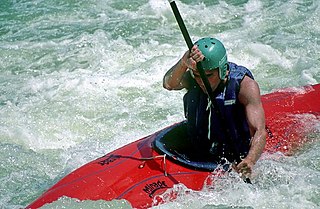
A kayak is a small, narrow human-powered watercraft typically propelled by means of a long, double-bladed paddle. The word kayak originates from the Inuktitut word qajaq. In British English, the kayak is also considered to be a kind of canoe.
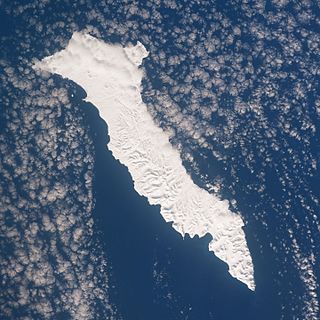
Bering Island is located off the Kamchatka Peninsula in the Bering Sea.
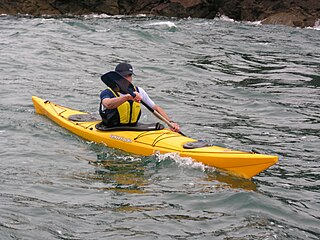
A sea kayak or touring kayak is a kayak used for the sport of paddling on open waters of lakes, bays, and oceans. Sea kayaks are seaworthy small boats with a covered deck and the ability to incorporate a spray deck. They trade off the manoeuvrability of whitewater kayaks for higher cruising speed, cargo capacity, ease of straight-line paddling (tracking), and comfort for long journeys.
A folding kayak is a direct descendant of the original Inuit kayak made of animal skins stretched over frames made from wood and bones. A modern folder has a collapsible frame made of some combination of wood, aluminium and plastic, and a skin made of a tough fabric with a waterproof coating. Many have integral air chambers inside the hull, making them virtually unsinkable.
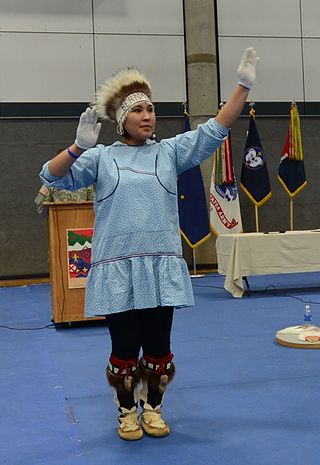
Alaska Natives are the Indigenous peoples of Alaska and include Russian Creoles, Iñupiat, Yupik, Aleut, Eyak, Tlingit, Haida, Tsimshian, and a number of Northern Athabaskan cultures. They are often defined by their language groups. Many Alaska Natives are enrolled in federally recognized Alaska Native tribal entities, who in turn belong to 13 Alaska Native Regional Corporations, who administer land and financial claims.
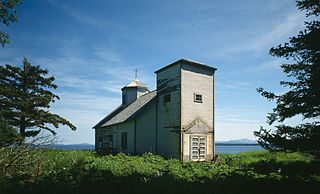
Afognak (; also Agw'aneq in Alutiiq was an Alutiiq village on the island of Afognak in Kodiak Island Borough, Alaska, United States. It was located on Afognak Bay on the southwest coast of the island, three miles north of Kodiak Island. The site is now within the CDP of Aleneva.
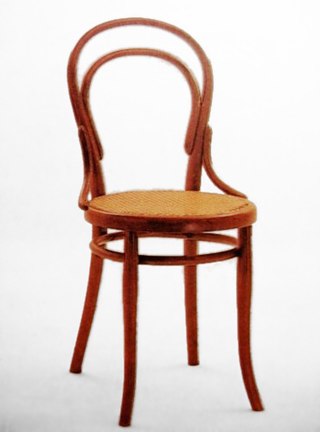
Bentwood objects are made by wetting wood, then bending it and letting it harden into curved shapes and patterns.

The umiak, umialak, umiaq, umiac, oomiac, oomiak, ongiuk, or anyak is a type of open skin boat, used by the Yupik and Inuit, and was originally found in all coastal areas from Siberia to Greenland. First used in Thule times, it has traditionally been used in summer, for moving people and possessions to seasonal hunting grounds, and for hunting whales and walrus. Although the umiak was usually propelled by oars (women) or paddles (men), sails—sometimes made from seal intestines—were also used, and, in the 20th century, outboard motors. Because the umiak has no keel, the sails cannot be used for tacking.

George Dyson is an American non-fiction author and historian of technology whose publications broadly cover the evolution of technology in relation to the physical environment and the direction of society. He has written on a wide range of topics, including the history of computing, the development of algorithms and intelligence, communications systems, space exploration, and the design of watercraft.

Prehistoric Alaska begins with Paleolithic people moving into northwestern North America sometime between 40,000 and 15,000 years ago across the Bering Land Bridge in western Alaska; a date less than 20,000 years ago is most likely. They found their passage blocked by a huge sheet of ice until a temporary recession in the Wisconsin glaciation opened up an ice-free corridor through northwestern Canada, possibly allowing bands to fan out throughout the rest of the continent. Eventually, Alaska became populated by the Inuit and a variety of Native American groups. Trade with both Asia and southern tribes was active even before the advent of Europeans.
The Aleutian Tradition is an archaeological culture which began around 2500 BC and ended in AD 1800. Aleutian artifacts are made out of chipped stone, unlike the ground slate tools used by archaeological cultures on the mainland of Alaska. The Aleutian people lived in semi-subterranean winter houses made from driftwood, whale bone, and peat. They used kayaks, atlatls and harpoons to kill sea mammals for sustenance. Around AD 1150, Aleutian houses increased considerably in size, food was stored in special chambers inside the house, and weaponry was becoming more common around these sites. The sustenance pattern changed from relying on sea mammals to eating mostly salmon. Long-distance trade also started increasing community with other local groups.

Shitik is a small, broad-bottomed vessel in which parts of the hull have been sewed with belts or juniper and fir-tree rods called vinya.

Sergie Sovoroff was an Aleut educational leader. He was born on Umnak Island in the Aleut village of Nikolski in 1902. Sergie encouraged others to learn basic survival skills in the Aleutians such as how to build an Unangam Ulax, and how to not starve to death, "A person should teach himself to eat things from the beach and from the land. Then in case of a food shortage, he could eat Aleut food and survive."

Andrew Gronholdt was a famous Aleut from Sand Point, Alaska, in the Shumagin Islands south of the lower Alaska Peninsula and became famous for rejuvenating the ancient Unangan art of carving hunting hats called chagudax. In January 2012, a book was published posthumously by Gronholdt titled "Chagudax: A Small Window into the Life of An Aleut Bentwood Hat Carver" Gronholdt's woodworking techniques, wood steaming and bending methods, and instructional design methodologies were legendary.

The Aleutian Islands —also called the Aleut Islands, Aleutic Islands, or, before 1867, the Catherine Archipelago—are a chain of 14 main, larger volcanic islands and 55 smaller ones. Most of the Aleutian Islands belong to the U.S. state of Alaska, with the archipelago encompassing the Aleutians West Census Area and the Aleutians East Borough. The Commander Islands, located further to the west, belong to the Russian federal subject of Kamchatka Krai, of the Russian Far East. The islands form part of the Aleutian Arc of the Northern Pacific Ocean, and occupy a land area of 6,821 sq mi (17,666 km2) that extends westward roughly 1,200 mi (1,900 km) from the Alaskan Peninsula mainland, in the direction of the Kamchatka Peninsula; the archipelago acts as a border between the Bering Sea to the north and the Pacific Ocean to the south. Crossing longitude 180°, at which point east and west longitude end, the archipelago contains both the westernmost and easternmost parts of the United States, by longitude. The westernmost U.S. island, in real terms, however, is Attu Island, west of which runs the International Date Line.

Yup'ik clothing refers to the traditional Eskimo-style clothing worn by the Yupik people of southwestern Alaska.

Unangan hunting headgear are wooden hats associated with the Unangan or Unangas, the Indigenous peoples of what are currently known as the Aleutian Islands.
Lydia was a US merchant ship that sailed on maritime fur trading ventures in the early 1800s. In December 1813 it was sold to the Russian–American Company and renamed Il'mena, also spelled Ilmena and Il'men'. As both Lydia and Il'mena it was involved in notable events. Today it is best known for its role in an 1814 massacre of the Nicoleño natives of San Nicolas Island, which ultimately resulted in one Nicoleño woman, known as Juana Maria, living alone on the island for many years. These events became the basis for Scott O'Dell's 1960 children's novel Island of the Blue Dolphins and the 1964 film adaptation Island of the Blue Dolphins.
Galagatax̂ is a mythical creature in the Unangax̂ culture of the Aleutian Islands, Alaska.




















